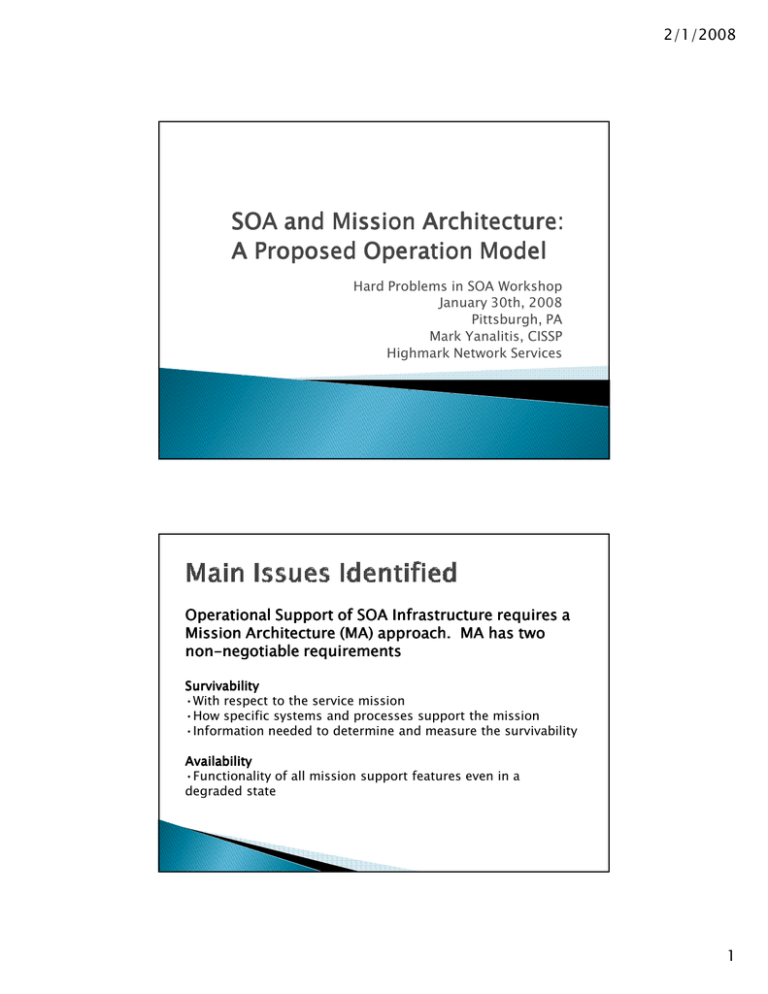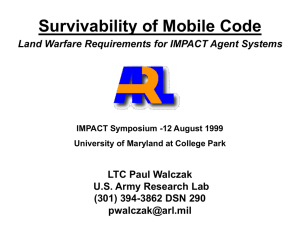SOA and Mission Architecture:
advertisement

2/1/2008 SOA and Mission Architecture: A Proposed Operation Model Hard Problems in SOA Workshop January 30th, 2008 Pittsburgh, PA Mark Yanalitis, CISSP Highmark Network Services Operational Support of SOA Infrastructure requires a Mission Architecture (MA) approach. MA has two nonnon-negotiable requirements Survivability •With respect to the service mission •How specific systems and processes support the mission •Information needed to determine and measure the survivability Availability •Functionality of all mission support features even in a degraded state 1 2/1/2008 [Lack of Structure] - Rationale Mission Architecture targets weakly established and brittle processes, programs, platforms, or services created by quickquick-fix solutions that make architecture harder to modify in the future. MA focuses the work effort on: • Continuity of operations and the operational state • Ensuring no component (staffing, technology, process, work instruction, finance, measurement) is considered immune or exempt. [ Lack of Structure] – Current Efforts The SOASOA-MA support encapsulation model A Service Program [a service offering] The Service Mission ◦ A Service Manager [a person] The SOA Mission Architecture (SOA-MA) The Core MA Operational Elements Staff (employees, contractors, vendors, consultants, volunteers, sponsors) Process – defined input leading to a defined output Work Instruction – How to manipulate the input and handle the output (ITIL Framework) Technology – COTS, development, acquisition, modification Finances – purchase, maintenance, pricing, procurement, licensing, depreciating, budgeting Measurement – functional performance measures 2 2/1/2008 [ Lack of Structure] – Challenges SOASOA-MA Service managers must steward SOASOA-MA by evangelizing …the horizontal routing of requests, tasks, and projects, across service organizations. ...”build once, leverage everywhere.” …”creativity and innovation; growth will follow.” … functional excellence, not superior performance. …monitoring and correction of performance defects as soon as they surface. …survivability and availability. [ Lack of Structure] – Ideas to address Challenges and Gaps Admit that variables outside of your mission architecture are part of your mission architecture - whether you want to admit it or not. Appreciate that all performance pressure is on the service manager. Large and complex services create greater performance pressure (vice-versa). A service manager has to have a strong sense of purpose and be willing to push into problems – sometimes other people’s deliberately unaddressed problems. 3 2/1/2008 [Agile Operations] - Rationale The Hierarchy vs. The Matrix A staffing hierarchy is not agile enough to accommodate the amount of tacit knowledge and agility required for successful SOA-MA. A hybrid mindset is required where the ‘networked’ staff serves the hierarchy. The Service Backplane The service backplane is a mindset that glues the staff to mission architecture by emphasizing service oriented support horizontally across infrastructure, business, systems, and infrastructure support areas. [Agile Operations] – Current Efforts A SERVICE PROGRAM THE SERVICE MANAGER (One or more senior level staff and/or management member) THE MISSION ARCHITECTURE FOR A SERVICE OFFERING MUST HAVE AVAILABILITY (non-negotiable) MUST HAVE SURVIVABILITY (non-negotiable) THE SERVICE BACKPLANE Route Traffic, Tasks, Requests, and Projects horizontally WHY? The business model going forward is horizontal. LOB vertical organization is inefficient and suffer from coordination, cooperation, cognition, and visibility problems. Convert staff effort into value. WHY? “Build once, leverage everywhere” The internal business model requires staff to invest time and effort in places where the greatest return is realized. Innovation is the most important capability for growth Achieve functional excellence under nominal performance WHY? The outcome of “doing nothing” is known. Growth is a function of change. Innovation spurs change. Change creates opportunity. WHY? There are no brilliant people in the room. Nominal achievement is reasonable – consistent long term performance within a reasonable set of metrics is the goal. Monitor your performance WHY? All efforts to build anything go through seven SOA phases: Create, Model, Assemble, Certify, Deploy, Manage, Retire. THE SERVICE OFFERING STAFFING ADEQUACY FINANCIAL COMPLETENESS ALIGNED TECHNOLOGY PROCESS MATURITY MEASUREMENT MATURITY Staffing Element Finance Element Technology Element ITIL Work Instruction Elements Measurement Element 4 2/1/2008 [Agile Operations] – Challenges Obstacles to SOASOA-MA: Cognition problems (seeking answers to the wrong questions) Coordination problems (getting every one to eventually demonstrate the same behavior) Cooperation problems (Overcoming narrow selfinterest and distrust) Visibility problems (system and process behaviors poorly understood or constrained by incomplete views) [Agile Operations] – Ideas to Address Challenges and Gaps Emphasis Management Science over Software Tooling. An analysis framework is only as sensitive as the analyst methods which manipulate data. Otherwise, SOA-MA performance becomes stuck in data collection, and may not reach real analysis. Standardize upon a codified taxonomy of SOASOA-MA variables. All variables must be measureable and reliable indicators of mission risk. All SOA analytics and performance measurement areas subscribe to the taxonomy. The taxonomy assures consistent data collection and structure analysis methods. 5





